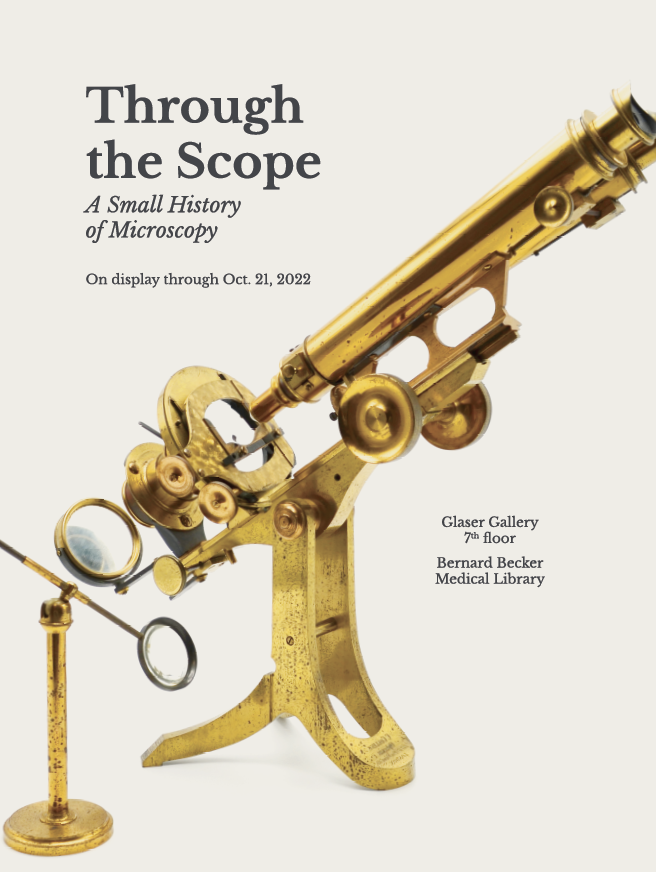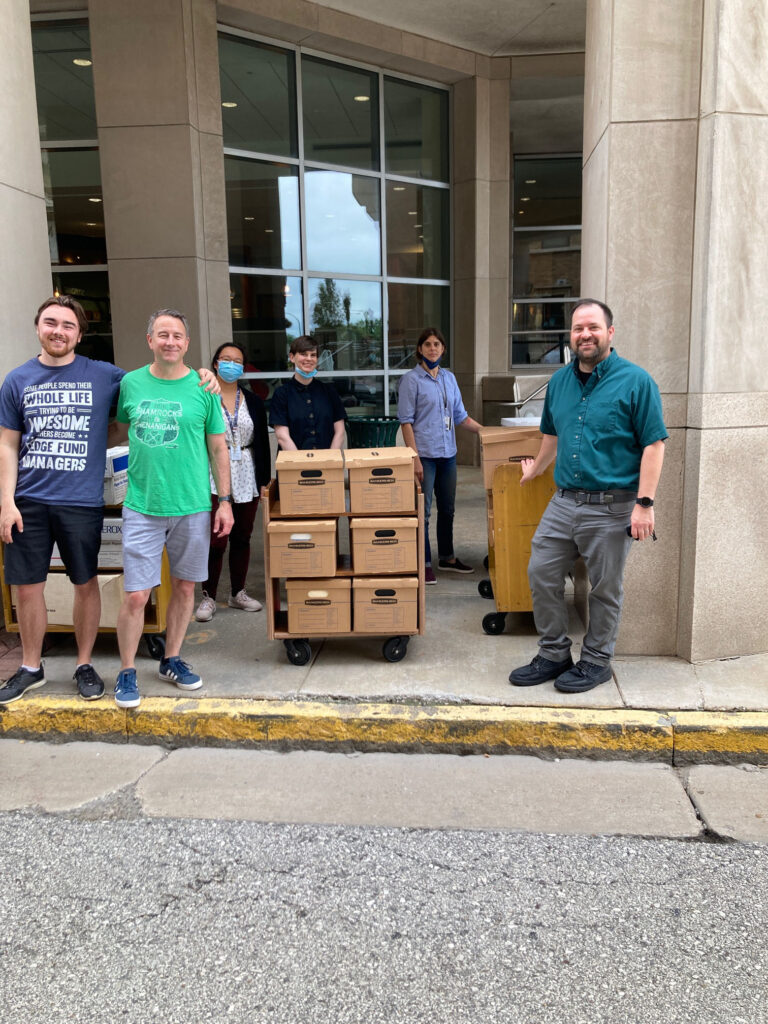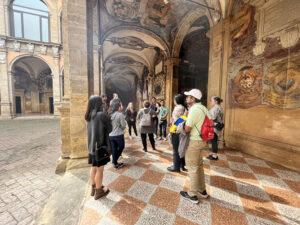Rare books and archives illuminating the birth of medicine as a scientific endeavor and Washington University’s place in medical history.
Supporting Research
A comprehensive index of WashU Medical Center publications
An extensive index to Washington University Medical Center publications is now available via the Becker Archives Database. This new resource consists of nearly 7,000 index headings for faculty, staff, departments, programs, and events related to the School of Medicine and its affiliated hospitals. Collectively, the index headings point to over 35,000 unique citations in medical center newsletters and magazines published over the course of the last century.

Travel scholarship
Elizabeth Bishop, PhD, was awarded the Fall 2022 travel scholarship. She is an Associate Professor of History at Texas State University who spent the week of December 5-9, 2022 at the Becker Archives researching our collections that touched on medical uses of radioactive isotopes in the 1950s. She was particularly interested in Washington University’s role in researching radioactive Carbon-14, and faculty connections between the university and the Manhattan Project.
Inaugurated in 2001, this continuous series of lectures on the history of medicine is presented four to six times annually throughout the spring and fall semesters.
- Alessandro Poletto, PhD. “Diagnosing illness at the Heian court: onmyōji and esoteric Buddhist monks at the time of the Tale of Genji”. April 19, 2023.
- Ezelle Sanford III, PhD, Carnegie Mellon University. “When Disparities Remain: The Enduring Legacy of Segregated Medicine”. Feb. 23, 2023
- Kristina Kleutghen, PhD. “A new vision: Chinese spectacles and eyesight in “A History of Lenses” (1681)”. Sept. 21, 2022.

Exhibitions presented in the Robert J. and Helen H. Glaser History of Medicine Gallery on the 7th floor of the library.
‘In their own words: Stories on the desegregation of Washington University Medical Center’
Feb. 23, 2023-June 9, 2023
Following Dr. Sanford’s talk, join us for refreshments at the opening of our latest Glaser Gallery exhibit. Drawing on oral histories, photographs, architectural plans and other documents, our first exhibit of 2023 will feature stories from doctors, nurses, students and administrators who experienced segregation and advocated for change.

How Did We Get Hear? Historic Hearing Devices, 1800-2000. (November 2022-
February 2022)
Oct. 26, 2022-Feb. 15, 2023
This exhibit highlights the long history of hearing devices, from conversation tubes to transistors, featuring devices from The Central Institute for the Deaf-Max A. Goldstein Historic Devices for Hearing Collection.
Through the Scope: A Small History of Microscopy
June 17, 2022-Oct. 21, 2022
The invention of the microscope revealed the invisible and enabled new fields of biomedical research. This exhibit explored a small history of microscopy, from Robert Hooke’s “Micrographia” to the electron microscope, through artifacts in the Becker special collections including the first electron microscope used in a biomedical investigation in the United States.
Additions to Becker Library Historical Collections and Archives
Rare Book Acquisitions
The rare books division continued to expand its holdings in alignment with its acquisition strategy in the areas of non-western medicine, popular medicine, and existing collections. Throughout FY23, a sum of fourteen new texts became part of its holdings. The division is grateful to the Bernard Becker family and the Seib family who made these acquisitions possible.
Major accessions to Becker Archives
There were two notable accessions to the Becker Archives in the past fiscal year: the Albert H. Fuller Papers and the Jerome Cox Papers.
Dr. Albert Fuller (1841-1912) was an 1871 graduate of both the St. Louis Medical College and the Missouri Dental College (predecessors of the Washington University School of Medicine and School of Dentistry respectively). After his service in the American Civil War, Dr. Fuller served as a professor of Operative Dentistry at the Missouri Dental College, and Dean from 1899-1901. This small collection highlights the personal documents of an accomplished dental surgeon and educator of the late 19th century. Included in this collection are three diaries he kept during his service in the Union Army throughout the Civil War, personal correspondence, and scrapbooks and lecture cards relating to the classes he taught at the Missouri Dental College.
Dr. Jerry Cox (1925-2023) was a long-time faculty member at Washington University who served as the director of research at the Central Institute for the Deaf, the chair of the Computer Laboratories at the medical campus, and the founder and chair of Department of Computer Science. This extensive collection highlights the significant contributions he made to incorporate the use of computers in biomedical research including radiation treatment planning, cardiac arrhythmia detection, and computer programming in the use of CT and PET scanners to diagnose cancer and evaluate treatment. Read more about this acquisition in the blog post.


Outreach and interpretation
When Disparities Remain: The Enduring Legacy of Segregated Medicine
The library hosted the two-part Legacies of (De)segregated Medicine event on February 23, 2023. The event began with a presentation by Stephen Logsdon on the history of segregation at the Washington University School of Medicine, which was followed by the 84th Historia Medica Lecture titled When Disparities Remain: The Enduring Legacy of Segregated Medicine by Dr. Ezelle Sanford III, Assistant Professor at Carnegie Mellon University. Following the lecture, an opening reception was held for the Glaser Gallery exhibit In Their Own Words: Stories of Desegregation at Washington University Medical Center on the library’s 7th floor.
Tour of Dr. H. Phillip Venable Memorial Park

Another unique program tied to the desegregation exhibit featured a tour of Dr. H. Phillip Venable Memorial Park in Creve Coeur, Missouri, on Tuesday, May 2, 2023. This informative tour of Venable Park was led by Dr. Geoff Ward, a Professor of African & African American Studies at WU, and by Meredith McKinley, a public art consultant employed by the city of Creve Coeur.
Student Tour of Italy
On March 18, 2023, sixteen intrepid Phase I medical students headed to Italy to spend spring break exploring the connections between anatomy and art in Renaissance Italy. Spending three nights in Venice and three nights in Florence, they went on a whirlwind tour of some of the most important sites in the history of medicine and the fine arts.

The Center for the History of Medicine sponsored a spring break trip to Italy for Phase I medical students interested in the history of medicine. Accompanied by Professor of Anatomy Kari Allen and Center for the History of Medicine Director Elisabeth Brander, students visited key sites in northern Italy to explore the history and cultural context of Renaissance anatomy. The experience gave participants a greater sense of both the heritage of their chosen profession and how medicine does not exist in a vacuum but is heavily influenced by the culture in which it is practiced.
Before departure, students attended an orientation session in Becker Library’s special collections reading room, where they viewed a selection of the library’s Renaissance-era texts.
These included such seminal works as Andreas Vesalius’s De humani corporis fabrica and Giovanni Morgagni’s De Sedibus et Causis Morborum, as well as texts by other key figures, including Mondino de Luzzi and Ulisse Aldrovandi. Attending these sessions helped lay the groundwork and provide context for what students would see on the trip itself.
Once in Italy, students walked in the footsteps of the anatomists whose works they saw at the library. The highlights of the trip were visits to Bologna and Padua, home of the two universities that stood at the peak of Italian medicine. In Bologna, students sat in the historic anatomy theatre in the Archiginnasio building, in the center of the ancient university. They then visited the Palazzo Poggi, where they viewed the university’s historic anatomical collections, including full-size wax figures displaying the muscles and bones, ceramic models of human gestation, and other anatomical and pathological specimens.

Padua is similarly rich in medical heritage. Its original 16th-century wooden anatomy theatre is still extant, and students had the chance to stand inside and look up at the wooden rails where
medical students once crammed together to observe dissections. They also explored the historic Palazzo Bo and learned about the structure and culture of early modern universities.
One of the trip’s key themes was the close ties between art and medicine. To that end, participants also visited some of Italy’s most important artistic landmarks. Many Italian Renaissance artists such as Leonardo, Michelangelo, and Tintoretto either studied anatomy
themselves or served as illustrators for the period’s anatomical publications. Seeing their works in art galleries and public spaces gave a vivid demonstration of how Italy’s religious and artistic culture influenced Renaissance scientific illustration.
The response essays students wrote at the end of the trip reveal that they found the experience engaging and thought-provoking:
“Overall, I believe this trip to Italy has reinvigorated my interest in anatomy as I no longer perceive it solely through anatomy lab, but instead of through the lens of how beautiful the human body is and how lucky I would be to directly manipulate it to promote someone’s health. In one of our first coaching groups, we were told to write a letter to ourselves about our hopes for our medical education. In my letter, I remember writing that I hoped that I would maintain my sense of wonder and guard against cynicism. Standing there [in the Padua anatomy theatre] was definitely a moment of wonder, at both the history that came before and how much progress has been made since then.”
“I find it difficult to disconnect the body in front of me [in the anatomy lab] from the life that was lived in it. Before, I believed that my conscious acknowledgment of her humanity was a personal fault. It was a distraction that kept me from fully immersing myself in the educational experience. Since Italy, I have found solace in remembering her body once housed a soul. In the Renaissance, scientists had to rely primarily on qualitative observations, which forced them to develop keen visual and artistic senses. In contemporary medicine, on the other hand, we depend heavily on quantitative data — probably more so than “simpler” qualitative impressions.
“While in Florence, standing before the inspiring Michelangelo’s David statue, I asked myself if perhaps we should not take a page out of our predecessors’ book, and slightly turn back the dial to a point where we might value more what we can see and touch.”
The Center considers this trip a success and intends to continue the program by offering a trip to the Netherlands in 2024.
The Fantastical Anatomical Collections of Frederick Ruysch
This one-day symposium focused on the work of Frederick Ruysch, an anatomist of the Dutch Golden Age known for creating spectacular tableaux with anatomical and pathological specimens. It featured presentations by Danforth faculty members Rebecca Messbarger and Claudia Swan, St. Louis Art Museum curator Elizabeth Wyckoff, and a keynote by Joanna Ebenstein, who edited a recent volume of Ruysch’s work.
Annual Display of Rare Anatomical Texts
The rare book division’s annual display of rare anatomical texts was held in person for the first time since 2019.
Other Outreach Activities
The rare books division hosted a visit from Quill and Scalpel, the undergraduate medical humanities club; continued its partnership with Olin Library for WU by leading the discussion on The Book of Madness and Cures, and spearheaded the annual Color Our Collections event by creating coloring books and promotional material.

